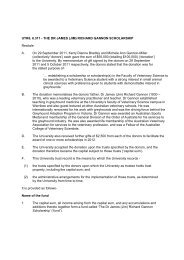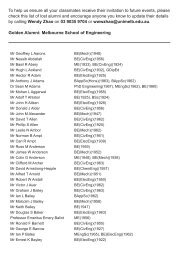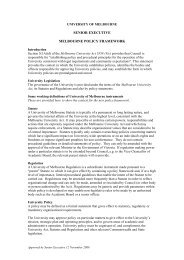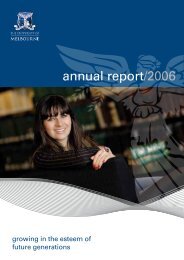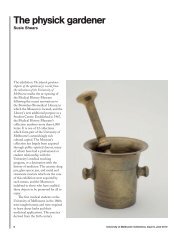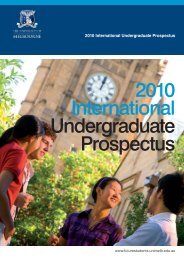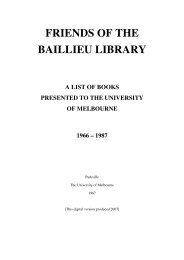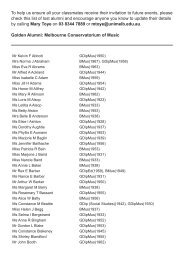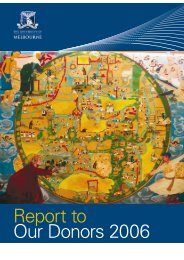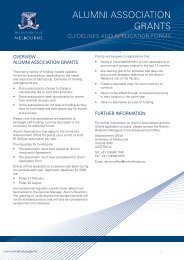2007 Annual report (PDF 8.1 Mb) - University of Melbourne
2007 Annual report (PDF 8.1 Mb) - University of Melbourne
2007 Annual report (PDF 8.1 Mb) - University of Melbourne
Create successful ePaper yourself
Turn your PDF publications into a flip-book with our unique Google optimized e-Paper software.
FINANCIAL<br />
STATEMENTS<br />
NOTE 32: FINANCIAL INSTRUMENTS<br />
32.1 Financial Risk Management Objectives and Policies<br />
The consolidated entity’s principal financial instruments consist mainly <strong>of</strong> listed and unlisted shares, unit trusts, and borrowings. The<br />
main purpose <strong>of</strong> these financial instruments is to raise finance to support the Group’s activities. The Group has various other financial<br />
instruments such as accounts receivable and accounts payable, which arise directly from its operations.<br />
The Group is exposed to key financial risks, including market risk (which includes interest rate risk, price risk and foreign currency risk),<br />
credit risk and liquidity risk. This note presents information about the Group’s exposure to each <strong>of</strong> these risks, and the objectives, policies<br />
and processes for measuring and managing risk.<br />
The <strong>University</strong>’s Council has overall responsibility for the establishment and oversight <strong>of</strong> the Group’s risk management framework. The<br />
Council has established:<br />
> the Finance Committee, which meets regularly to monitor and evaluate the <strong>University</strong>’s financial management strategies in the<br />
context <strong>of</strong> the most recent economic conditions and forecasts,<br />
> the Investment Management Committee, which monitors and advises the Finance Committee on <strong>University</strong>’s short term cash<br />
management and long term investments, and<br />
> the Audit and Risk Committee, which is responsible for developing and monitoring risk management policies.<br />
Primary responsibility for identification and control <strong>of</strong> financial risks rests with the Finance Committee, under the authority <strong>of</strong> Council. The<br />
Finance Committee reviews and makes recommendations to Council in relation to the <strong>University</strong>’s financial policies and risk management<br />
policies and procedures.<br />
32.2 Risk Exposures<br />
The main risks the Group is exposed to through its financial instruments are as follows:<br />
(a) Market Risk<br />
Market risk is the risk that changes in market prices will affect the Group’s result or the value <strong>of</strong> the Group’s financial assets and<br />
liabilities. The key market risks that the Group is exposed to are interest rate risk, foreign currency risk and price risk, each <strong>of</strong> which<br />
are discussed below.<br />
(i) Interest Rate Risk<br />
The Group’s exposure to market interest rates relates primarily to the Group’s long-term borrowings and funds invested<br />
on the money market. The interest rate on the <strong>University</strong>’s long term borrowings is fixed, and therefore the Group is not<br />
exposed to any material interest rate risk. The interest rate on the <strong>University</strong>’s borrowings is capped at 7.32% under a Bill<br />
Acceptance and Discount Facility.<br />
(b)<br />
All borrowings are subject to approval by the <strong>University</strong> <strong>of</strong> <strong>Melbourne</strong> Council and the Treasurer <strong>of</strong> Victoria.<br />
The Group has minimal exposure to interest rate risk through its holding <strong>of</strong> cash assets and other financial assets at fair<br />
value. At the <strong>report</strong>ing date, if interest rates were 1% lower/higher than the year-end rates with all other variables held<br />
constant, the Group’s net result for the year would have been $1,905,000 lower/higher (2006, $1,489,000 lower/higher),<br />
reflecting the lower/higher interest income earned on affected balances.<br />
The Group manages its interest rate risk primarily through fixing its interest rate on long term borrowings and by<br />
maintaining a diversified investment portfolio.<br />
(ii) Foreign Currency Risk<br />
The Group’s main exposure to foreign currency risk arises from International Shares held as part <strong>of</strong> its long term investment<br />
portfolio. The Group is mainly exposed to US dollars and the British Pound. At the <strong>report</strong>ing date, had the Australian Dollar<br />
weakened/strengthened by 10% against the relevant foreign currencies with all other variables held constant, the Group’s<br />
equity balance would have been $16,018,000 lower/higher (2006, $3,866,000 lower/higher), due to changes in the fair<br />
value <strong>of</strong> available-for-sale financial assets. There would have been no change to the net result for the year (2006, Nil).<br />
At times, the <strong>University</strong> will hedge large equipment purchases denominated in foreign currencies to manage foreign<br />
currency risk. The <strong>University</strong> did not undertake any hedging during <strong>2007</strong> (2006, Nil).<br />
(iii) Price Risk<br />
The <strong>University</strong> has a significant investment in marketable securities (included within available-for-sale financial assets),<br />
which exposes the Group to price risk. To limit this risk, the <strong>University</strong> has invested its funds with Fund Managers and<br />
maintained a diversified investment portfolio. The majority <strong>of</strong> the equity investments are <strong>of</strong> a high quality and are publicly<br />
traded on equity exchanges. The investments are mainly included in the S&P/ASX 200 Index.<br />
The sensitivity analysis has been determined based on the Group’s exposure to equity prices. At the <strong>report</strong>ing date, if the<br />
value <strong>of</strong> marketable securities were 10% lower/higher with all other variables held constant, the Group’s equity would<br />
have been $132,910,000 lower/higher (2006: $126,650,000 lower/higher), due to changes in the fair value <strong>of</strong> available-forsale<br />
financial assets. There would have been no change to the net result for the year (2006, Nil).<br />
Credit Risk<br />
Credit risk is the risk <strong>of</strong> financial loss to the Group if a customer or counterparty to a financial instrument fails to meet its contractual<br />
obligations. Credit risk arises principally from the Group’s receivables from customers.<br />
The Group does not have any material credit risk exposure to any single receivable or group <strong>of</strong> receivables. The Group’s exposure<br />
to credit risk is influenced mainly by the individual characteristics <strong>of</strong> each customer. Receivable balances are monitored on an<br />
ongoing basis to ensure that the exposure to bad debts is not significant. The Group has established an allowance for doubtful debts<br />
that represents their estimate <strong>of</strong> incurred losses in respect <strong>of</strong> receivables. An analysis <strong>of</strong> the ageing <strong>of</strong> the Group’s receivables at<br />
<strong>report</strong>ing date has been provided in Note 19.<br />
The <strong>University</strong> <strong>of</strong> <strong>Melbourne</strong> <strong>Annual</strong> Report <strong>2007</strong> 127






